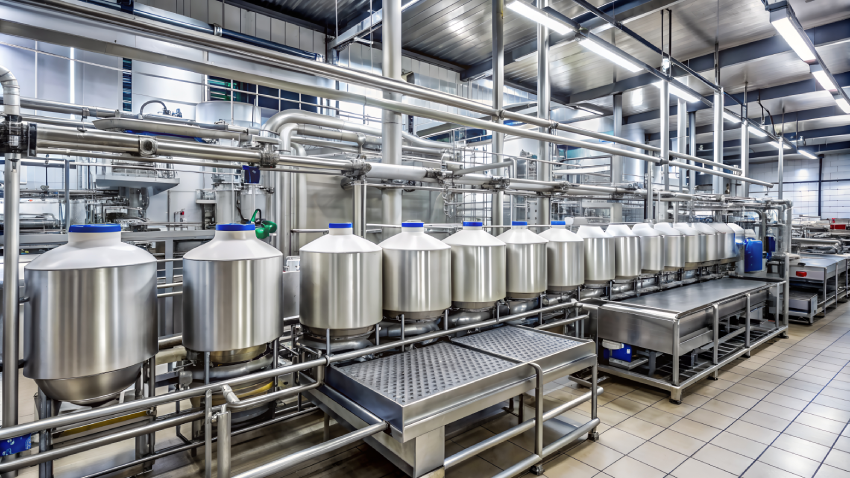A Overview of ERP Solutions for Dairy Manufacturers
Enterprise Resource Planning (ERP) systems change the way dairy producers manage their businesses. These ERP solutions give manufacturers the power to boost effectiveness, ensure they comply with regulations,, and streamline supply chain management by combining diverse business processes into one simplified system. This article provides a summary of ERP solutions for Dairy Manufacturers, shines a light on the stages of putting these systems in place, roles within supply chains, improving compliance efforts, and deciding between using physical or cloud-based systems.
The Phases of Implementation of ERP Plans
To effectively implement an ERP system is a process with multiple stages. It requires detailed planning, teamwork, and implementation. Dairy Manufacturers benefit from a systematic way that makes sure the solution matches their operation’s unique demands, like obeying regulatory standards, managing inventory, and controlling quality. Now, let’s explore the crucial phases of implementing ERP systems:
Preparation and Planning
Establishing a solid foundation for successful ERP implementation is achieved in the preparation and planning phase. The tasks involved at this level include:
- Understand business needs: It is important for Dairy Manufacturers to fully evaluate their requirements. They need to know where the current procedures fall short and set clear aims for the ERP system. Do supply chain management inefficiencies provoke hold-ups? Is there a solid routine to manage inventory? These questions help determine the most critical ERP features.
- Stakeholder Engagement: To consider everyone’s needs, it is important to involve stakeholders from different departments. The opinions of production groups, quality-checking quality-checking teams, and logistics are necessary for selecting and setting up an ERP that fulfills the requirements across the entire company.
- Choosing the Suitable ERP Supplier: Not every ERP system is created equal, so choosing a supplier with knowledge of dairy production is essential. You should search for elements like batch tracking ability, tools to ensure compliance, and the ability to combine existing systems.
- Creating a Comprehensive Schedule: An implementation schedule helps maintain the course of the project. This schedule should embrace key events for each stage, from design to support after deployment. Proper planning prevents unexpected changes and gives realistic expectations for time schedules and expenses. Setting up a project management group at this point assures smooth cooperation during the execution phase.
Design and Customisation
The design and customisation process is about setting up the ERP system to match the dairy manufacturer’s operational needs. This stage is crucial for adjusting the system to specific workflows and it consists of:
- Integration of Modules: Functions such as quality control, production scheduling, and inventory management in dairy operations require specific ERP modules. For instance, the utilisation of FIFO (First In, First Out) and FEFO (First Expired, First Out) systems can be incorporated by inventory management modules to enhance stock rotation and minimise waste—understanding “what FIFO means” along with its application results in excellent inventory management.
- Custom Processes: Each Dairy Manufacturer works differently. Tailoring processes, whether for the treatment of milk or making cheese, guarantee that the ERP system integrates well with current practices.
- Features for Regulatory Compliance: Following the rules of food safety is an essential part of making dairy products. ERP solutions often come with a compliance tracking system built-in to make it easy to adhere to local and worldwide standards. In this step, work closely with the ERP supplier to ensure that all changes align with business objectives and operational norms.

Data Migration
Moving information from old systems to the new ERP is one of the most complex and vital steps in the operation process. Things you should consider include:
- Data Cleaning and Validation: Before moving data, the manufacturers need to remove duplicated or old info to ensure the validity of the data. Correct data ensures the new system works efficiently.
- Map Structure of Data: Data from old systems must synchronise with the new ERP solution. Details like product codes, information about suppliers, and batch numbers must comply with the new system’s configuration.
- Checking the Transfer Procedure: A trial run of data migration verifies whether the transfer is smooth and whether the new system works properly when integrated with the migrated data.
ERP Testing
ERP testing confirms that the system works as planned before it is fully implemented. The thorough testing includes several steps:
- Unit Testing: Separate parts of the ERP, like the inventory unit or supply chain monitor, are tested separately to confirm their working condition.
- Integration Testing: The next step is to test how various modules operate in combination. For example, the production planning module must interact efficiently with the inventory and quality control modules.
- User Acceptance Testing (UAT): This is when the final users test the system in practical situations to ensure it fulfills necessary operations. The feedback from those who manage production and quality is very important for improving the system.
- Stress Testing: In this stage, we create conditions of high demand to see how the ERP behaves during peak operation times, such as when there is a sudden increase in production due to seasonal changes.
Thorough testing reduces the risk of system failures post-implementation, ensuring a smooth transition.
Training and Change Management
Even the most sophisticated ERP system will not work well without appropriate user usage. Education and transformation management strategies are key to ensuring that workers accept this new system. Here’s what to consider:
- Specialised Training: Custom-made training schedules for different departments guarantee that users understand how to use the system for their unique assignments. For example, the production team can concentrate on batch monitoring, whereas inventory groups learn how to apply the FEFO framework.
- Practical Teaching Meetings: Engaged learning, with live showings and practice modules, assists workers in building assurance for system usage.
- Change Management Strategies: When an ERP system is implemented, it frequently brings about substantial alterations to workflows. Approaching change management in a forward-thinking manner and consistently highlighting the ERP’s merits can reduce opposition and enhance morale.
Correct teaching ensures that workers can quickly and effectively use the ERP system and maximise its advantages.
Deployment and Go-Live
When the ERP system is formally launched, it is called the deployment phase. Two main methods are available for dairy producers to choose from:
- Once-Off Implementation: All ERP modules are activated at the same time. Although this method is quicker, it requires detailed preparation and checks to lessen potential problems.
- Gradual Introduction: Modules are implemented step by step. This allows the team to handle problems on a smaller scale before they become bigger issues. For example, a Dairy Manufacturers could introduce the stock module before introducing production planning. In this step, technical support must be easily accessible for urgent problems. Paying close attention to system performance in the first weeks of deployment is essential for a good transition.
Post-Implementation Support
The journey does not stop when it’s deployed; continuous assistance is essential for the prolonged achievement of an ERP system. The main tasks in this stage encompass:
- Problem-solving and Renewal: Taking care of any technical problems, while ensuring the system stays updated with new characteristics.
- Performance Checking: Frequent system checks ensure that the ERP still satisfies the changing requirements of dairy production. This could involve assessing new sections or characteristics. Continuing training courses for new staff or improving the system maintains the workforce in sync with the ERP’s abilities.
- Planning for Expandability: As the dairy business grows, an ERP system that can adapt and manage higher production levels, more complex supply chain activities, and stricter rules is necessary.
Post-implementation support ensures that the ERP system evolves alongside the business, providing sustained value.
The Role of Dairy ERP in Supply Chain Management
ERP systems are very important in simplifying Dairy Manufacturers’ supply chain operations. ERP helps manage a supply chain by joining different parts into one united platform, which provides better supervision and control. Some of the functions of dairy ERP in supply chain management include:
- Inventory Management: The ERP system can handle inventory using approaches such as FIFO (First In, First Out) and FEFO (First Expired, First Out). These are beneficial for the ideal rotation of stock. FIFO prioritises using the oldest stock first, while the FEFO system ensures products near their expiry date are used or sent out first. These methods are crucial for managing dairy items that spoil quickly.
- Supplier Coordination: ERP solutions make communication with suppliers more efficient by automatically processing orders and checking supplier performance. They decrease delay times and guarantee regular quality.
- Predicting Demand: ERP systems examine past sales data and market tendencies to assist makers in accurately forecasting demand. This helps avoid situations of excess production or running out of stock.
- Instant Monitoring: ERP software provides instant monitoring for products throughout the supply chain, guaranteeing the ability to trace and allow quick responses to any disruptions.
Improving Dairy Manufacturing with Compliance ERP
Compliance is a very important concern for Dairy Manufacturers because they must follow strict industry regulations and ensure food safety standards are met. ERP compliance systems have been created specifically to assist companies in adhering to these guidelines while continuing operations smoothly. Here are some of the ways that compliance ERP can improve a dairy manufacturer’s business:
- Quality Control: ERP compliance systems include quality control modules following each production step. These modules automatically check and record to ensure that both raw materials and final products align with regulation standards.
- Traceability: Control agencies often ask Dairy Manufacturerss to monitor their goods from the making process to distribution. An ERP system provides complete traceability and allows for quick response in case of product recalls or inspections.
- Document Management: Compliance ERP solutions bring all documentation together in one place, making getting certificates, audit trails, and regulatory filings easier. It makes reporting less complex and lowers the chance of penalties for not following rules.
- Automatic Warnings: Automatic warnings inform producers about probable regulation problems, like changes in temperature or manufacturing procedures, permitting immediate rectification measures to be implemented.

On-Premise vs Cloud-Based ERP Solutions in Dairy Production
When choosing an ERP solution, dairy producers often consider the advantages of on-site systems over cloud-based ERP solutions. Both choices have their unique benefits:
On-Premise ERP Benefits
The benefits of on-premise ERP include:
- Control and Personalisation: On-premise solutions provide more control over data and system setups, which makes them perfect for businesses with particular requirements.
- Safety: Because data is kept locally, systems on-site can offer more security for sensitive information.
- Initial Costs: On-site solutions require a large sum at the beginning because they require hardware and infrastructure. However, their continuous expenses can be reduced.
Cloud-Based ERP Benefits
The benefits of cloud-based ERP include:
- Accessibility: ERP cloud computing allows users to access the system from anywhere they have an internet connection. This supports working remotely and operations in multiple locations.
- Scalability: Cloud-based solutions are easily scalable, accommodating business growth without significant infrastructure changes.
- Lower Capital Investment: With pricing based on a subscription, ERP solutions in the cloud have smaller initial costs, making them within reach for small and medium-sized businesses.
- Automatic Updates: ERP systems based on the cloud get updated regularly, making sure manufacturers always use the most recent technology.
The choice between on-premise and cloud-based ERP systems is determined by aspects like budget, operational needs, and future business goals. Many manufacturers in the dairy industry are gradually choosing mixed solutions to take advantage of advantages from both sides.
From executing ERP strategies and examining systems to leveraging observance and cloud computing skills, ERP solutions cater to the exclusive issues of dairy production. For an adapted ERP solution that matches your firm’s precise requirements, SoftTrace offers ground-breaking dairy management solutions for improving operations and promoting expansion. Contact us today to learn more about how we can make your dairy production company prosper.
